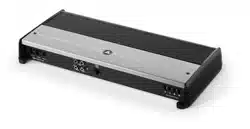Loading ...
Loading ...
Loading ...

8 | JL Audio - XD1000/1v2 Owner’s Manual
INPUT SENSITIVITY CONTROLS
The control labeled “Input Sens.” can be used
to match the source unit’s output voltage to the
input stage of the XD1000/1v2 for maximum
clean output. Rotating the control clockwise will
result in higher sensitivity (louder for a given
input voltage). Rotating the control counter-
clockwise will result in lower sensitivity (quieter
for a given input voltage).
To properly set the amplifier for maximum
clean output, please refer to Appendix A (page
12) in this manual. After using this procedure,
you can then adjust the “Input Sens.” levels
downward if this is required to achieve the
desired system balance.
Do not increase any “Input Sens.” setting for
any channel(s) of any amplifier in the system
beyond the maximum level established during
the procedure outlined in Appendix A (page 12).
Doing so will result in audible distortion and
possible speaker damage.
FILTER CONTROLS
Most speakers are not designed to reproduce
the full range of frequencies audible by the human
ear. For this reason, most speaker systems are
comprised of multiple speakers, each dedicated
to reproducing a specific frequency range. Filters
are used to select which frequency range is sent
to each section of a speaker system. The division
of frequency ranges to different speakers can be
done with passive filters (coils and/or capacitors
between the amplifier outputs and the speakers),
which are acceptable and commonly used
for filtering between mid-range speakers and
tweeters. Filtering between subwoofer systems
and satellite speaker systems is best done with
active filters, which cut off frequency content at
the input to the amplifier. Active filters are more
stable than passive filters and do not introduce
extraneous resistance, which can degrade
subwoofer performance.
The active low-pass filter built into the
XD1000/1v2 is designed to attenuate frequencies
above its filter frequency, so that the system’s
subwoofers do not reproduce any audible
midrange content.
This serves to improve tonal balance
and to avoid distortion. Correct use
of the filter can substantially improve
the fidelity of your audio system.
2) LP Filter Operation: The low-pass filter in the
XD1000/1v2 is fully variable between 50 Hz
and 500 Hz via the “Filter Freq.” control knob
(80 Hz is a good starting point for tuning most
systems). The filter also features the ability to
select between a moderate “12dB” per octave
or a steep “24dB” per octave slope via the “LP
Filter Mode/Slope” switch.
Depending on the subwoofer system and
the vehicle, different slopes may be required
to produce a smooth transition to the mid-
bass speakers in the system. Experiment to
find the slope which best matches the acoustic
requirements of your system.
Tuning Hint: A trunk mounted sub whose
output has to “fight” through a rear deck or a
backseat often benefits from the 12 dB/octave
slope which lets more upper bass content pass
through. A sub that fires directly into the
listening environment is more likely to benefit
from a 24 dB/octave slope.
Loading ...
Loading ...
Loading ...
